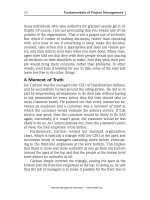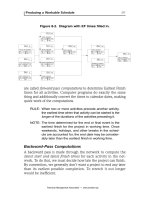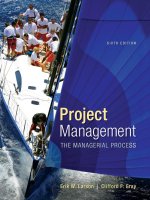Exploring management 6th by schermerhornch05
Bạn đang xem bản rút gọn của tài liệu. Xem và tải ngay bản đầy đủ của tài liệu tại đây (375.99 KB, 34 trang )
Exploring Management
John Schermerhorn, Jr. and Daniel G. Bachrach
Sixth Edition
Chapter 5
Plans and Planning Techniques
“Considering the future of our children and young
people… we have no choice but to go ahead with
the village-wide evacuation.” ~ Mayor Noro Kanno
of Kawamata-cho town, after a 9.0 earthquake and
monster tsunami wrecked nuclear power facilities
in Fukushima, Japan.
Copyright ©2018 John Wiley & Sons, Inc.
2
Your Chapter 5 Takeaways
• How and why do managers use the planning process? (5.1)
• What types of plans do manager use? (5.2)
• What are some useful planning tools and techniques? (5.3)
Copyright ©2018 John Wiley & Sons, Inc.
3
HOW AND WHY MANAGERS PLAN 5.1
Takeaway 5.1 – answers to come
• Planning is one of the four functions of management.
• Planning sets objectives and identifies how to achieve them.
• Planning improves action orientation.
• Planning improves coordination and control.
• Planning improves time management.
Copyright ©2018 John Wiley & Sons, Inc.
4
How and why managers plan 5.1
Planning is One of the Four Functions of Management
FIGURE 5.1 Why Does Planning Play a Central Role in the Management Process?
Copyright ©2018 John Wiley & Sons, Inc.
5
How and why managers plan 5.1
Planning Sets Objectives and Identifies How to Achieve Them
How to Implement the Planning Process
Step 1. Define your objectives. Know where you want to go; be specific enough to know you have arrived when you get there and how far off you are
along the way.
Step 2. Determine where you stand vis-à-vis objectives. Know where you presently stand in reaching the objectives; identify strengths that work in
your favor and weaknesses that can hold you back
Step 3. Develop premises regarding future conditions. Generate alternative scenarios for what may happen; identify for each scenario things that may
help or hinder progress toward your objectives.
Step 4. Make a plan. Choose the action alternative most likely to accomplish your objectives; describe what must be done to implement this course of
action.
Step 5. Implement the plan and evaluate results. Take action; measure progress toward objectives as implementation proceeds; take corrective actions
and revise the plan as needed.
Copyright ©2018 John Wiley & Sons, Inc.
6
How and why managers plan 5.1
Planning Improves Focus
Good Planning Makes Us and Our Organizations . . .
Action oriented Planning gives us a results-driven sense of direction.
Priority oriented Planning highlights the most important things for our attention.
Advantage oriented Planning makes sure that resources are used to best advantage.
Change oriented Planning helps us to anticipate and deal with problems and opportunities.
Control oriented Planning forces us to make sure results match objectives.
Copyright ©2018 John Wiley & Sons, Inc.
7
How and why managers plan 5.1
Planning Improves Action Orientation
• Planning focuses attention on priorities and helps us avoid the complacency trap of being
passively carried along by the flow of events.
• It’s easy to be lulled into inaction by the successes or failures of the moment.
• Instead of being caught in the present, however, planning keeps us alert and actively moving
toward the future.
• planning gives us not only an action orientation but also one guided by a clear set of
priorities.
Copyright ©2018 John Wiley & Sons, Inc.
8
How and why managers plan 5.1
Planning Improves Coordination and Control
• Planning links with control so success can be measured
• Hierarchy of objectives – lower level objectives help accomplish higher ones
FIGURE 5.2 How Might a Hierarchy of Objectives Guide a Quality Management Program in a Manufacturing
Firm?
Copyright ©2018 John Wiley & Sons, Inc.
9
How and why managers plan 5.1
Planning Improves Time Management
How to Better Manage Your Time
Set priorities for what really needs to get done.
Work on the most important things first.
Leave details for later, or delegate them to others.
Say “No!” to requests that divert attention from your priorities.
Take charge of your schedule; don’t let others control what you do and when.
Stick with your choices; not everything deserves immediate attention.
Block social media to avoid “pop up” distractions; open and use social media when relevant to the task at hand.
Copyright ©2018 John Wiley & Sons, Inc.
10
How and why managers plan 5.1
Study Guide for Takeaway 5.1
Rapid Review:
•
•
•
Planning is the process of setting performance objectives and determining how to accomplish them.
•
The benefits of planning include better focus and action orientation, better coordination and control, and better time
management.
•
Planning improves time management by setting priorities and avoiding time wasters.
A plan is a set of intended actions for accomplishing important objectives.
The steps in the planning process are: (1) define your objectives; (2) determine where you stand vis-à-vis objectives; (3)
develop premises regarding future conditions; (5) make a plan to best accomplish objectives; (5) implement the plan,
and evaluate results.
Copyright ©2018 John Wiley & Sons, Inc.
11
How and why managers plan 5.1
Study Guide for Takeaway 5.1
Questions for Discussion:
1.
2.
3.
Should all employees plan, or just managers?
Which step in the planning process do you think is the hardest to accomplish?
How could better planning help in your personal career development?
Copyright ©2018 John Wiley & Sons, Inc.
12
How and why managers plan 5.1
Be Sure You Can…for Takeaway 5.1
• explain the importance of planning as the first of four management functions.
• list the steps in the formal planning process.
• explain the important link between planning and controlling as management functions.
• illustrate the benefits of planning for a business or an organization familiar to you.
• illustrate the benefits of planning for your personal career development.
• list at least three things you can do now to improve your time management.
Copyright ©2018 John Wiley & Sons, Inc.
13
TYPES OF PLANS MANAGERS USE 5.2
Takeaway 5.2 – answers to come
• Managers use short-range and long-range plans.
• Managers use strategic and operational plans.
• Organizational policies and procedures are plans.
• Budgets are plans that commit resources to activities.
Copyright ©2018 John Wiley & Sons, Inc.
14
TYPES OF PLANS MANAGERS USE 5.2
Planning Horizons
• Short-range plans
• usually cover a year or less.
• Long-range plans
• Usually cover three years or more.
Copyright ©2018 John Wiley & Sons, Inc.
15
TYPES OF PLANS MANAGERS USE 5.2
Time Frames
Jaques’s Findings on Long-Term Thinking:
•
Most people are comfortable with 3-month time spans.
•
Some work well with a 1-year time span.
•
Only the rare person can handle a 20-year time span.
Copyright ©2018 John Wiley & Sons, Inc.
16
Types of plans managers use 5.2
Strategic and Operational Plans
• Strategic Plans identify broad and comprehensive long-term direction for the
organization.
• Vision is the purpose for the organization.
Copyright ©2018 John Wiley & Sons, Inc.
17
Types of plans managers use 5.2
Strategy
• Operational Plans identify activities to implement strategic plans.
• Functional Plans identify how different parts of the organization will contribute to the overall
strategy.
• Financial plans
• Facilities plans
• Marketing plans
• Human resource plans
• Production plans
Copyright ©2018 John Wiley & Sons, Inc.
18
Types of plans managers use 5.2
Policies and Procedures are Plans
Policy
•
communicates broad guidelines for making decisions
Procedure
•
defines specific actions to be taken in specific situations
Copyright ©2018 John Wiley & Sons, Inc.
19
Types of plans managers use 5.2
Budgets are Plans
Budgets are plans that commit resources to activities, programs, or projects.
Types of budgets
• Financial budgets project cash flows and expenses.
• Operating budgets anticipate sales and revenue.
• Nonmonetary budgets allocate resources.
• Fixed budgets allocate set amounts to a specific purpose.
• Flexible budgets vary in proportion to a level of activity.
• Zero based budgets start from scratch.
Copyright ©2018 John Wiley & Sons, Inc.
20
TYPES OF PLANS MANAGERS USE 5.2
Study Guide for Takeaway 5.2
Rapid Review:
•
•
•
•
•
•
Short-range plans tend to cover a year or less, whereas long-range plans extend out to three years or more.
Strategic plans set critical long-range directions; operational plans are designed to support and help implement strategic plans.
Policies, such as a sexual harassment policy, are plans that set guidelines for the behavior of organizational members.
Procedures are plans that describe actions to take in specific situations, such as how to report a sexual harassment complaint.
Budgets are plans that allocate resources to activities or projects.
A zero-based budget allocates resources as if each new budget period is brand new; no “rollover” resource allocations are allowed
without new justifications.
Copyright ©2018 John Wiley & Sons, Inc.
21
TYPES OF PLANS MANAGERSE USE 5.2
Study Guide for 5.2
Questions for Discussion:
1.
2.
3.
Is there any need for long-range plans in today’s fast-moving environment?
What types of policies do you believe are essential for any organization?
Are there any possible disadvantages to zero-based budgeting?
Copyright ©2018 John Wiley & Sons, Inc.
22
TYPES OF PLANS MANAGERS USE 5.2
Be Sure You Can…for Takeaway 5.2
• differentiate short-range and long-range plans.
• differentiate strategic and operational plans.
• explain how strategic and operational plans complement one another.
• differentiate policies and procedures, and give examples of each.
• explain the benefits of a zero-based budget.
Copyright ©2018 John Wiley & Sons, Inc.
23
Useful planning Tools and techniques 5.3
Takeaway 5.3 – answers to come
•
•
•
•
•
•
•
•
Forecasting tries to predict the future
Contingency planning creates backup plans for when things go wrong
Scenario planning crafts plans for alternative future conditions
Benchmarking identifies best practices used by others
Participatory planning improves implementation capacities
Goal setting helps align plans and activities throughout an organization
Goals can have downsides and must be well managed
Participatory planning builds implementation capacities.
Copyright ©2018 John Wiley & Sons, Inc.
24
Useful planning Tools and techniques 5.3
Forecasting
Forecasting Tries to Predict the Future
• Qualitative forecasting relies on expert opinions.
• Quantitative forecasting relies on mathematical models and statistical analysis.
Copyright ©2018 John Wiley & Sons, Inc.
25









